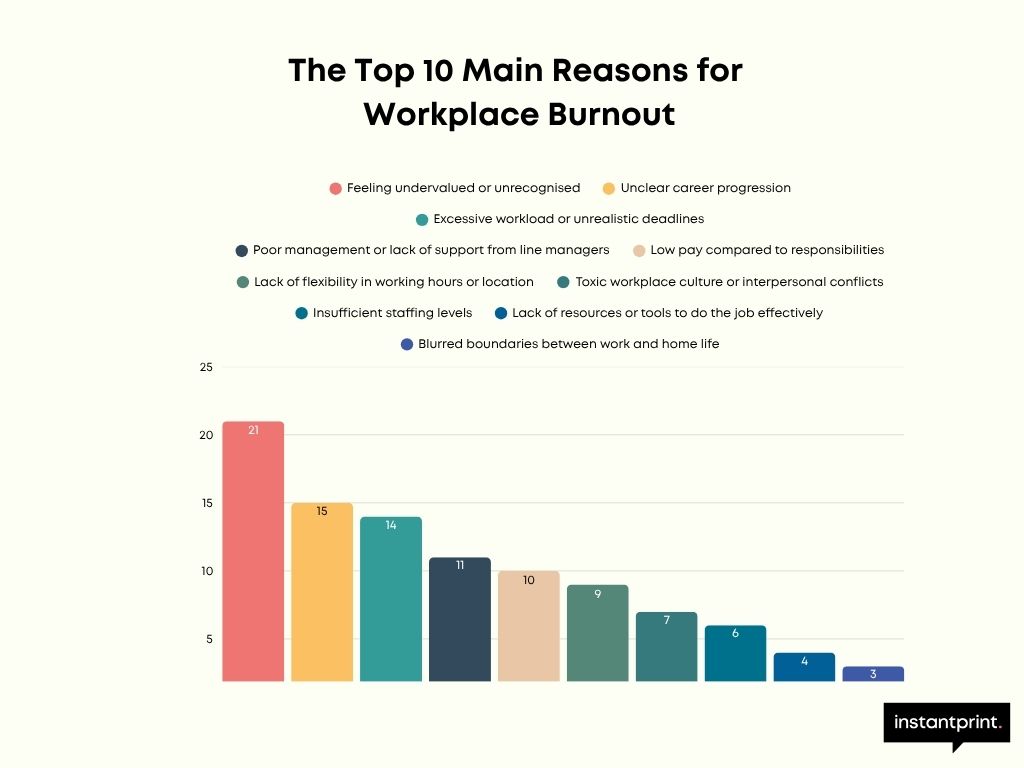One in four UK office workers admit they have ‘quiet quit’ in the last year, and a further 41% say they’ve seriously considered it, according to new research from instantprint. This silent withdrawal from work responsibilities is costing UK businesses millions in lost productivity, yet many managers miss the warning signs until it’s too late.
When the spark goes out: The hidden cost of quiet quitting
Quiet quitting isn’t about actually leaving a job, it’s about mentally checking out while staying on the payroll. Employees still clock in, meet the bare minimum requirements and avoid overt conflict, but the drive to go above and beyond vanishes.
Our survey of 2,000 UK office workers found that the average disengaged employee contributes 21% less output than their engaged peers. Across a team of 10, with the average UK salary at £37,430 (ONS, 2024), that’s £374,300 worth of salaries delivering reduced value. A 21% drop equates to about £78,600 lost each year, conservatively rounded to “almost £80,000.”
And what’s pushing people to the point of switching off? Our research reveals the top ten main reasons for workplace burnout:
1. Feeling undervalued or unrecognised – 21%
2. Unclear career progression – 15%
3. Excessive workload or unrealistic deadlines – 14%
4. Poor management or lack of support from line managers – 11%
5. Low pay compared to responsibilities – 10%
6. Lack of flexibility in working hours or location – 9%
7. Toxic workplace culture or interpersonal conflicts – 7%
8. Insufficient staffing levels – 6%
9. Lack of resources or tools to do the job effectively – 4%
10. Blurred boundaries between work and home life – 3%
When these issues are left unaddressed, the result is disengagement and if leaders aren’t looking closely, quiet quitting can slip under the radar for months.

Reading the room: 7 tell tale signs someone is quietly quitting
While it can be subtle, disengagement leaves clues. Spotting them early gives managers the chance to re-engage rather than replace.
According to our data, the top seven red flags include:
1. Declining participation – They used to contribute ideas in meetings, now they’re silent or distracted.
2. Minimal communication – Emails and messages are kept short, without the friendly tone they once had.
3. Strict clock-watching – Consistently logging off exactly on time, avoiding voluntary overtime.
4. Avoidance of new projects – Passing up opportunities to take on fresh responsibilities.
5. Drop in quality – Work that was once thorough is now just “good enough”.
6. Social withdrawal – Skipping after-work drinks, team lunches or casual chats.
7. Increased sick days – Especially around high-stress deadlines.

Vicki Russell: Turning observation into action
Vicki Russell, Head of TX (HR) at instantprint, says spotting these signs is only the first step — the real challenge is what you do next.
“Quiet quitting is rarely about laziness, it’s about disconnect. People don’t stop caring overnight, they stop feeling like their work matters. The worst thing a manager can do is jump straight to performance warnings without first finding out what’s driving the change.”
She advises managers and HR leaders to approach the issue like a human conversation, not a disciplinary meeting. That means starting with curiosity, listening actively and taking visible action to show the employee they’ve been heard.
From her experience, there are five high impact steps any leader can take to reignite engagement:
- Shadow days with senior leaders – Give disengaged employees a chance to see how their role impacts the bigger picture.
- Small wins recognition – Publicly acknowledge even minor improvements to rebuild confidence and motivation.
- Switching up project roles – Introduce a temporary shift in responsibilities to spark renewed interest.
- Quarterly ‘career check-ins’ – Hold separate conversations from performance reviews to focus purely on aspirations and progression.
- Micro-changes in workload – Trial small adjustments like redistributing a recurring task or altering meeting times to ease pressure points.
Vicki adds,
“When people feel valued and heard, their energy comes back. Sometimes, a simple change, like more flexible hours or clearer goals, can completely turn around someone’s attitude. But you only find that out if you take the time to ask.”
Reversing the trend before it’s too late
Gallup’s latest State of the Global Workplace report shows that only 10% of UK workers are actively engaged at work — meaning there’s a vast middle ground at risk of quiet quitting. Forward-thinking HR leaders who act early can turn this into an opportunity. By spotting subtle changes in behaviour, opening genuine dialogue and addressing the root causes, businesses can not only retain skilled employees but reignite their motivation.
Because in the end, a motivated team doesn’t just hit targets, they redefine what’s possible.



.jpg)

